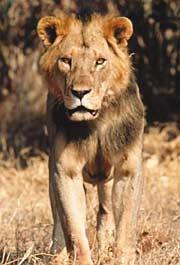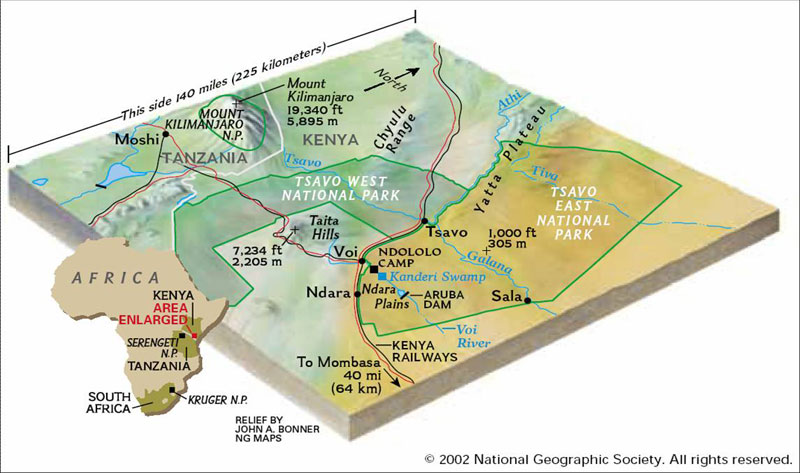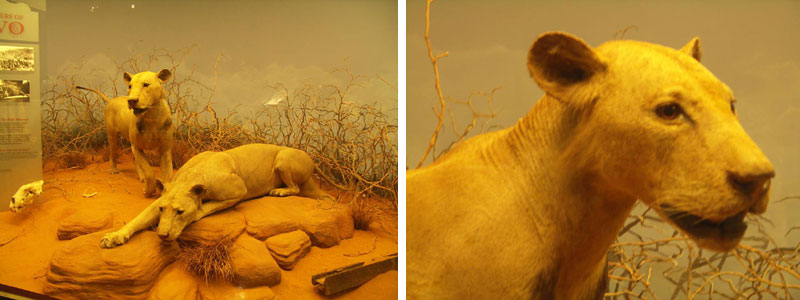
Male Tsavo lion Source: National Geographic
Man-Eating Lions of Tsavo
If you have seen the 1996 movie "The Ghost and the Darkness" with Val Kilmer
and Michael Douglas, then you know what we're talking about here! These maneless
lions (yes, the male Tsavo lions do not have the thick ring of hair around the
face) have quite an amazing history. But let's start with a little more background,
such as an introduction to the region and the events that led up to the 1898
killings of railway builders.
The Geography of Tsavo
Located in Kenya, Tsavo National Park is one of the world's largest national parks. Tsavo is larger than the island of Jamaica, nearly as big as the state of Massachusetts at more than 8,000 square miles, ranging from an arid eastern half to green, western hills that look out toward the ice-crowned peak of Mount Kilimanjaro, 75 miles away. The park is divided by a highway into the rolling scrub-covered hills of Tsavo East and rolling volcanic landscape of Tsavo West. Note the location of the Tsavo River on a map, as this is where the story of the man-eating lions of East Africa begins.

Map of Tsvao National Park Source: National Geographic. LAURA - is this from an online source that we could link to?
Note: Please click on the image to see a larger version.
The lions and the building of the railroad
In March 1898, the British started building a railway bridge over the Tsavo River. Over the next nine months, two large male lions killed and ate nearly 140 railway workers. Crews tried to scare off the lions and built campfires and thorn fences for protection, but to no avail. Hunders of workers fled Tsavo, halting construction of the bridge. Before work could resume, chief engineer Lt. Col. John Henry Patterson (1865-1947) had to eliminate the lions and their threat. After many near misses, he finally shot the first lion on December 9, 1898, and three weeks later brought down the second. The first lion killed measured 9 feet, 8 inches from nose to tip of tail. It took eight men to carry the carcass back to camp. The construction crew returned and completed the bridge in February 1899.
It has puzzled scientists for quite some time as to what triggered the lions to attack humans at that time, as lions rarely ate people. Two factors may have contributed to the need to feed on humans. First, in the 1890s, an outbreak of rinderpest disease killed millions of zebras, gazelles, and other African wildlife. The lions had to look elsewhere for food, and attacks on humans increased across the continent. Second, poor burial practices may have also contributed to the Tsavo tragedy. Railroad workers who died of injury or disease were often poorly buried, or not buried at all. A scavenging lion coming across an accessible human meal may have started going after live humans.
The lions of Tsavo at The Field Museum
If you ever get a chance to spend some time in Chicago, you should definitely stop by The Field Museum where you can see "Ghost" and "Darkness" on display! After completing the railroad, Lt. Col. Patterson became chief game warden in Kenya and later served with the British Army in World War I. He published four books and lectured widely on his adventures. After speaking at The Field Museum in 1924, Patterson sold the museum the lions' skins and skulls for the then-sizeable sum of $5,000.

"Ghost" and "Darkness" on display at The Field Museum. Source: Dr. Laura Guertin.
The skins arrived in less-than-perfect condition - old and dry, and they had been cut down into rugs. The skins were also blemished by gunshot wounds and thorn scratches. But Museum taxidermists went ahead and created life-like mounts of the maneless lions, as you can see above.
Listen to the story of the lions of Tsavo
National Geographic and the National Science Foundation have worked together to record "Pulse of the Planet," audio clips describing stories and modern-day issues with the lions of Tsavo. The audio includes interviews with scientists researching the lions and their environment. Take a listen to these short MP3 files to learn more.
- Lions of Tsavo: Ghost Story -- Pulse of the Planet [2:03 min]
- Lions of Tsavo: Man-Killers Still? -- Pulse of the Planet [2:05 min]
- Lions of Tsavo: Calling Them In -- Pulse of the Planet [2:03 min]
- Lions of Tsavo: High When Dry -- Pulse of the Planet [2:03 min]
What do YOU think? Man-Eating Lions of Tsavo - is it their fault?
Read the April 2002 National Geographic article on "Maneless Lions" and the National Geographic News report from January 4, 2004, "Man-Eating Lions Not Aberrant, Experts Say." Does the lack of manes make the Tsavo lions more agressive, or have they always been man-eaters? Post your thoughts and opinions to the Lesson 12 - Man-Eating Lions of Tsavo - is it their fault? Discussion Forum (you can easily find that discussion forum by looking under the Communicate tab in ANGEL).